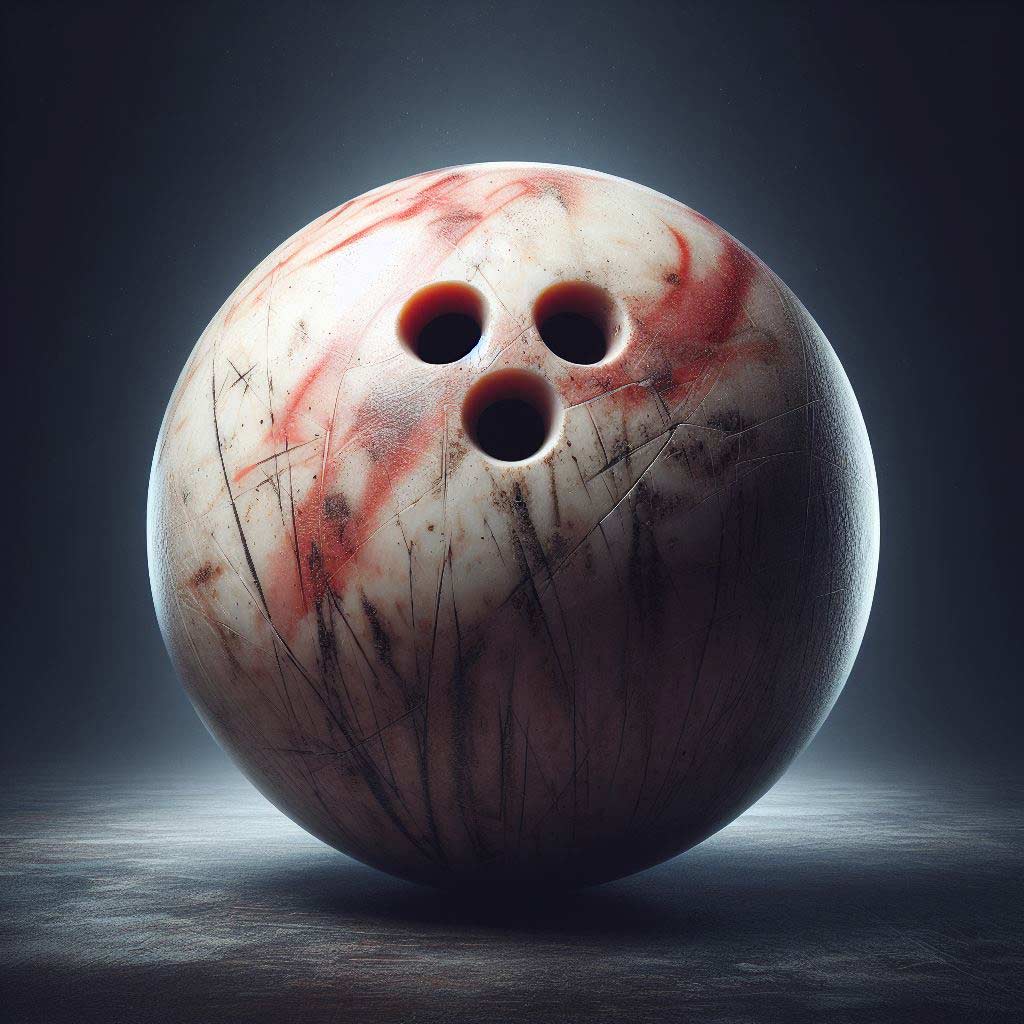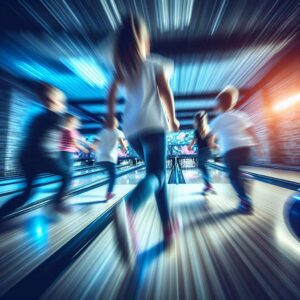If you’ve ever been in the middle of a bowling game and noticed your ball hooking less or losing its driving power, you’ve likely experienced the effects of a worn-out bowling ball.
As frustrating as it can be, the truth is that even the highest-quality bowling balls are not immune to wear and tear over time. Just like any other piece of sports equipment, bowling balls are subject to various factors that can cause them to deteriorate, affecting their performance and requiring replacement or resurfacing.
Whether you’re a casual bowler or a competitive player, understanding the causes and signs of bowling ball wear and tear is crucial to ensuring you’re always playing with equipment that’s in top condition.
In this comprehensive guide, we’ll dive deep into the world of bowling ball maintenance, exploring what causes balls to wear out, how to identify signs of wear, and the best practices for extending the lifespan of your gear.
What Causes Bowling Balls to Wear Out?
Bowling balls may be designed to withstand repeated impacts and rolls, but they’re not indestructible. Several factors can contribute to their wear and tear over time, including:
- Lane Conditioning and Friction: The constant friction between the ball and the lane surface, combined with the oils and conditioners used to dress the lanes, can gradually wear down the coverstock (outer shell) of the bowling ball. This friction can cause microscopic scratches and abrasions, leading to decreased hooking potential and performance.
- Impact and Collisions: While bowling balls are engineered to withstand impacts, repeated collisions with pins, gutters, and other balls can cause physical damage over time. Cracks, chips, and gouges in the coverstock can not only affect the ball’s performance but also compromise its structural integrity.
- Chemical Reactions: Bowling balls are susceptible to chemical reactions, such as oxidation, absorption of oils and lane conditioners, and interactions with cleaning agents. These reactions can cause discoloration, surface roughness, and changes in the ball’s chemical composition, ultimately affecting its performance.
- Manufacturing Defects or Flaws: In rare cases, bowling balls may be affected by manufacturing defects or flaws that can lead to premature wear or failure. These defects can include inconsistencies in the coverstock material, improper weight distribution, or internal delamination (separation of layers).
Signs That Your Bowling Ball Needs Attention
Knowing when your bowling ball needs attention is crucial to preventing further deterioration and ensuring optimal performance. Here are some common signs to watch out for:
- Physical Damage: Visible cracks, chips, or gouges in the coverstock are clear indicators that your ball has sustained physical damage and may require resurfacing or replacement.
- Decreased Hooking or Driving Power: If you notice your ball isn’t hooking or driving as much as it used to, it could be a sign of wear on the coverstock, affecting its ability to generate the desired motion and energy transfer.
- Changes in Ball Reaction or Motion: A worn ball may behave differently than it did when it was new, exhibiting unpredictable or inconsistent motion on the lanes. This can make it challenging to execute your shots consistently.
- Discoloration or Fading of the Coverstock: Fading or discoloration of the coverstock can indicate chemical degradation or oxidation, which can impact the ball’s performance and appearance.
Factors That Influence Bowling Ball Lifespan
While all bowling balls are subject to wear and tear, their lifespan can vary depending on several factors:
- Coverstock Material: The type of coverstock material used in a bowling ball can significantly affect its durability and resistance to wear. Reactive resin coverstocks, for example, are known for their aggressive hooking potential but may wear down faster than particle coverstocks, which are more durable but offer less hooking.
- Frequency of Use: The more you use your bowling ball, the faster it will wear down. Balls used in high-frequency environments, such as bowling alleys or pro shops, will experience more wear and tear than those used occasionally for recreational purposes.
- Proper Care and Maintenance: Proper care and maintenance practices, such as regular cleaning, resurfacing, and proper storage, can significantly extend the lifespan of your bowling ball.
- Storage Conditions: Exposure to extreme temperatures, humidity, and UV light can accelerate the degradation of bowling ball coverstocks. Storing your balls in a cool, dry, and dark environment can help preserve their condition.
Bowling Ball Care and Maintenance Tips
Implementing proper care and maintenance practices is essential for maximizing the lifespan of your bowling balls. Here are some tips to keep in mind:
- Cleaning and Degreasing: Regular cleaning and degreasing of your bowling ball can remove built-up oils, lane conditioners, and dirt, which can cause premature wear and affect the ball’s performance. Use a specialized bowling ball cleaner and follow the manufacturer’s instructions.
- Resurfacing and Polishing: Periodic resurfacing and polishing can help restore the coverstock’s original condition and remove scratches, scuffs, and other surface imperfections. This can be done at a local pro shop or bowling center.
- Proper Storage: Store your bowling balls in a cool, dry, and dark environment, away from direct sunlight and extreme temperatures. Use a bowling ball case or bag to protect them from scratches and impacts during transportation.
- Handling and Transportation: Avoid dropping or mishandling your bowling balls, as this can cause physical damage. Use a bowling ball case or bag when transporting them, and never store other heavy items on top of your balls.
When to Replace vs. Resurface Your Bowling Ball
Deciding whether to replace or resurface your bowling ball can be a tough call. Here are some factors to consider:
- Cost Considerations: In general, resurfacing a bowling ball is more cost-effective than replacing it entirely. However, if the ball has sustained significant damage or is very old, replacement may be the better option.
- Performance Requirements: If you’re a competitive bowler who relies on precise ball reaction and performance, replacing a worn ball with a new one may be necessary to maintain a competitive edge. For recreational bowlers, resurfacing may suffice.
- Age and Condition of the Bowling Ball: Older balls or those with significant wear and tear may not perform as well after resurfacing, making replacement a more viable option.
Professional Insights and Recommendations
To gain a deeper understanding of bowling ball wear and tear, we consulted with industry experts and pro shop professionals. Here are some valuable insights and recommendations:
Advice on Extending the Lifespan of Bowling Balls:
Bowling ball manufacturers and pro shop experts recommend the following practices to maximize the lifespan of your bowling balls:
- Use a bowling ball case or bag to protect your balls during transportation and storage.
- Avoid exposing your balls to extreme temperatures or direct sunlight for extended periods.
- Clean and degrease your balls after every use, following the manufacturer’s instructions.
- Consider resurfacing your balls every 60-80 games or as needed to maintain optimal performance.
- Replace heavily damaged or severely worn balls, as resurfacing may not restore their original performance.
Recommendations for Different Bowling Styles and Skill Levels:
For recreational bowlers:
- Invest in a durable particle coverstock ball that can withstand occasional use and minor wear and tear.
- Resurfacing your ball every few seasons or as needed should be sufficient to maintain its performance.
For competitive bowlers:
- Consider having a rotation of multiple bowling balls with different coverstock materials and reactions to accommodate various lane conditions.
- Reactive resin balls may need to be replaced more frequently due to their aggressive hooking and faster wear.
- Regularly resurfacing and maintaining your balls is crucial for consistent performance.
For high-rev players:
- Choose a coverstock material that can withstand the increased friction and wear caused by high rev rates.
- Particle or hybrid coverstocks may be more suitable for high-rev players compared to reactive resin.
- Regular resurfacing and maintenance are essential to compensate for the increased wear.
Conclusion:
As we’ve explored in this comprehensive guide, bowling balls are not immune to the effects of wear and tear. Even the most premium and well-maintained balls will eventually succumb to the cumulative impact of lane friction, collisions, and chemical reactions over time.
While the lifespan of a bowling ball can vary greatly depending on factors like coverstock material, frequency of use, and adherence to proper care practices, recognizing the signs of deterioration is crucial. From decreased hooking power to visible cracks and discoloration, these warning signs indicate it’s time to take action.
For competitive bowlers seeking peak performance, replacing a severely worn ball may be the best solution. But for many recreational players, resurfacing can breathe new life into a beloved piece of equipment and extend its usability. Ultimately, it’s about striking the right balance between cost, performance needs, and the ball’s overall condition.
By following the expert-recommended maintenance routines outlined in this guide, such as regular cleaning, degreasing, resurfacing, and proper storage, you can maximize the longevity of your bowling gear. Investing in the right care not only preserves your equipment but also ensures a consistent and enjoyable bowling experience for years to come.





